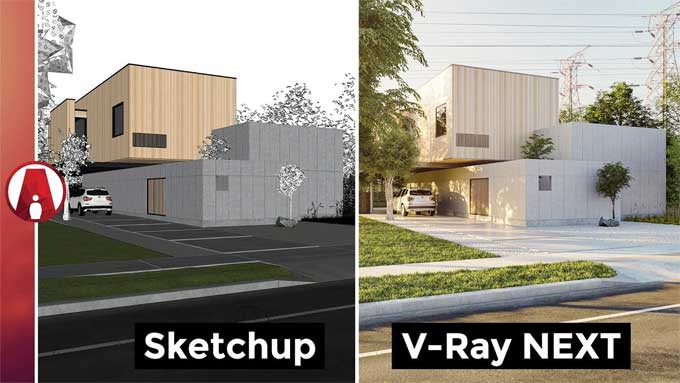The 6 Best SketchUp Rendering Methods using V-Ray

V-Ray is a 3D rendering software that is the number one choice for architectural visualization that has been battle-tested and used to build world-class buildings, products, and much more. For those who have a lot of time for creativity but still care about producing the highest quality image, V-Ray lets you quickly and easily render everything from 3D models to concept sketches in the highest quality.
V-Ray's impressive power and ease of use reflect in its remarkably simple interface. In addition, SketchUp integrates seamlessly with the application's multi-faceted 3D modeling tools, as well as a full set of tools for lighting and materials creation. V-Ray produces great results without requiring you to be a rendering expert.
Methods of V-Ray Rendering
V-Ray's simple interface illustrates this in these 6 methods, which details how simple it is to create a basic project using it. you will also learn how to manage your Materials, Lights, Geometry, Render Elements, and Textures in a simple way.
1. Exterior Lighting in Daylight
You will learn how to quickly set up exterior lighting for a daylight scenario in this first method. It also shows you how to tweak the Sunlight and Dome light settings for achieving your desired effects. You can't beat a bright, sunny scene with sunlight streaming through, but if you only arrange windows and no other light sources and hit render, it'll look dark and unappealing.
Unlike real cameras, V-Ray's camera does not work the same way. Neither does it capture light bouncing off surfaces, nor does it automatically adapt to changing conditions. Therefore, the render that only uses sunlight to illuminate it has a few hidden light effects.
2. Interior Lighting in Daylight
In this step, you'll learn how to light an arch-viz interior. You will learn simple lighting workflows for rendering interiors in SketchUp by the end of this method, which builds on the exterior lighting methods above.
3. Exterior Lighting at Night
Continuing the arch-viz workflow work flow guides, this method guide will show you how to set up a nighttime exterior render. You can achieve great-looking night renders by using the simple workflow that is demonstrated.
4. Interior Lighting at Night
You will now learn how to set up a nighttime lighting project for an interior. It illustrates how to adjust your lighting and colors for a more realistic look and simulate moonlight very easily.
5. Atmosphere & Fog Creation
V-Ray renders parameters have a section called Volumetric Environments, where you can view and adjust the setting for volumetric effects, aerial perspective, and environmental fog.
As the name suggests, the Aerial Perspective atmospheric effect simulates an aerial perspective, a similar effect to fog or haze, which originates in the Earth atmosphere and has an effect on distant objects. As the atmosphere and the sun work together, an approximate aerial perspective effect calculates. A V-Ray Environment Fog effect simulates clouds, dust, and fog as particle media.
6. Materials Creation & Uses
With this method, you will be able to edit preset materials using the Material Library, create new materials from scratch and create a new material using the Material Library.
Wrapping it Up
The Materials method in V-Ray Next for SketchUp explains the fundamentals of materials. Simulations of fog, dust, and smoke are obtained easily with Environment Fog.
You will learn how to animate images with 3D volumetric effects and use Aerial Perspective to illustrate distance with atmospheric haze.
To learn more, watch the following video tutorial.
Video Source: Architecture Inspirations



